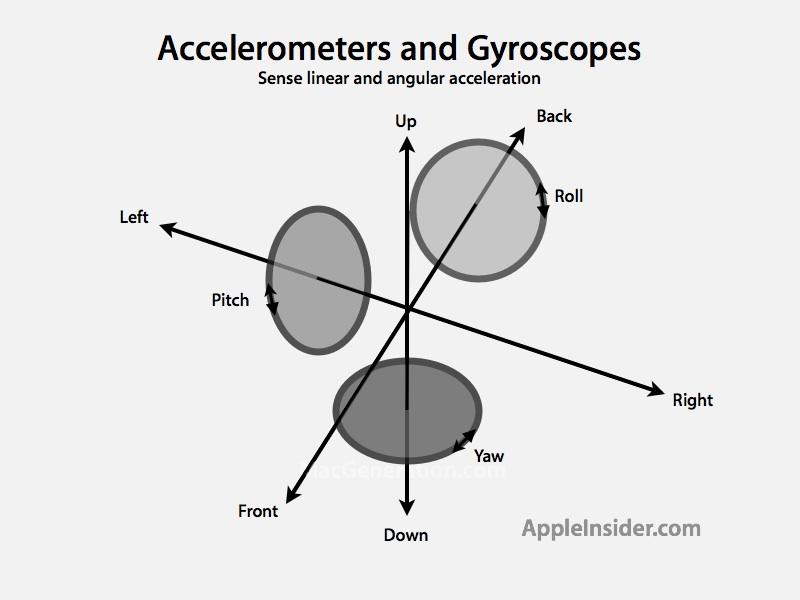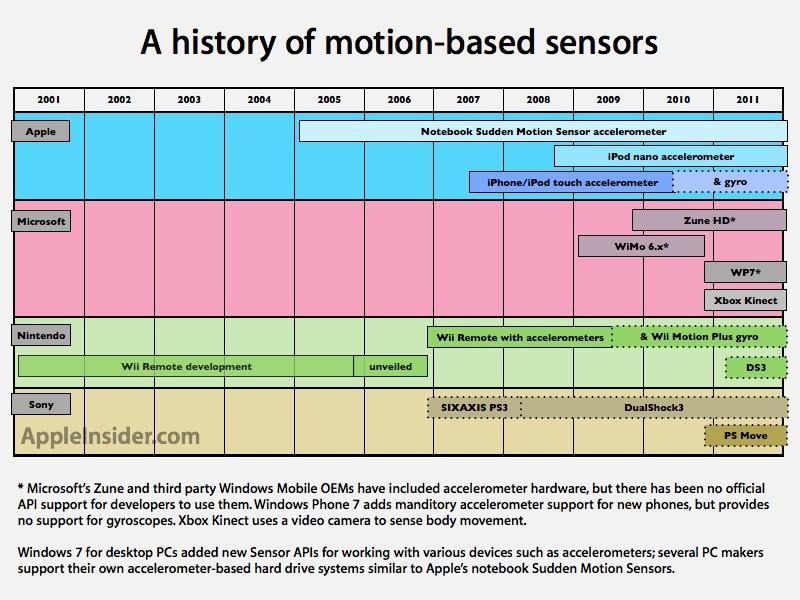On stage at WWDC, chief executive Steve Jobs was expected to have little new to show about iPhone 4, given that a prototype version had been stolen and publicly dissected weeks before the event. Fortunately for Apple, most of its key details weren't grasped by the prototype's leakers.
Nothing about the new Retina Display was leaked apart from the fact that the new phone appeared to have a much higher resolution display, something everyone expected anyway. Leaks only assumed the presence of an A4 brain and faster 802.11n WiFi. Additionally, nobody guessed that the stainless steel shell would double as an antenna system for WiFi, Bluetooth, GPS and 3G. The leak also didn't anticipate any details of Apple's standards-based FaceTime video calling.
The biggest secret however might have been the new phone's gyroscope, a feature that beat to market the fancy phones from Nokia's Symbian and Google's Android. Few who bought into Android phones from Verizon and Sprint over the past six months will be ready to pay up to $350 in early termination fees just to grab the next gyro-equipped models one they eventually come out. Microsoft has also admitted that it won't be ready to support gyros or digital compasses in Windows Phone 7 at its end of the year launch.
That makes Apple's gyro introduction, tied to the mega-launch of the new iPhone 4, a big deal in terms of differentiating Apple's platform. Jobs' announcement of the new gyroscope feature generated an enthusiastic, instantaneous whoop from a few developers at the WWDC keynote who understood what it meant. For everyone else, Jobs had a demonstration planned involving a 3D Jenga-style game that allowed for an entirely new type of motion feedback.
On page 2 of 4: What's a gyroscope?
Apple's original iPhone popularized the accelerometer, a type of sensor that can detect a device's acceleration, shake, vibration shock, or fall by detecting linear acceleration along one of three x, y and z axes: up/down; right/left and front/back. The company had earlier used accelerometers in its notebooks as "Sudden Motion Sensors" in order to park the hard drive in anticipation of hitting the floor, to avoid hard drive damage related to a drop.
On the iPhone and iPod touch (and recent iPod nanos), 3-axis accelerometers enable landscape/portrait orientation switching, tilt control for games, and shake features such as undo and song shuffle. Because they only measure linear motion, they can't sense compass direction or subtle twisting motions or rotation about gravity.
In the iPhone 3GS, Apple added a digital compass (magnetometer), which can additionally sense magnetic direction relative to the Earth's poles. The iPhone 4 gyroscope adds an additional new electronic sensor for detecting 3-axis angular acceleration around the X, Y and Z axes, enabling precise calculation of pitch, yaw and roll.
While conventional accelerometers measure linear acceleration as a change in velocity (speed increasing or decreasing over time) apart a change of direction, a gyro measures angular acceleration: a change in both velocity and direction at the same time. In iPhone 4, the gyro enables the device to sense slight degrees of rotation while rejecting linear movements and hand jitters, while its accelerometer senses those linear movements.
Combined with data from the accelerometer and compass, the gyro provides detailed, precise information about the device's six-axis movement in space: the 3 axes of the gyro, combined with the 3 axes of the accelerometer enable the device to recognize how far, fast, and in which direction it has moved in space. Apple makes this information available to developers through new CoreMotion APIs, sparing them the need to be experts in physics just to add gyro support to their apps.
On page 3 of 4: Video game commotion about motion
Apple's new gyro not only beat other smartphone makers to market, but also premiered ahead of motion-based controls on dedicated gaming devices. Nintendo won't bring accelerometer and gyro support to its new Nintendo 3DS until March 2011. Sony's PSP Go, released last fall, has neither type of motion sensor built in and has announced no plans to add any (while it can theoretically be used with Sony's SIXAXIS controller for the PS3, nobody is supporting that sort of thing today, nor does it make much sense for a handheld device to use a separate controller).
The iPhone 4's gyro introduction resonated with new announcements at E3 related to the leading video game console vendors, each of whom were demonstrating their own new motion-based gaming technologies for their gaming consoles.
In video game consoles, accelerometer-based motion control was pioneered by Nintendo, which around 2001 bought up patents from Gyration pertaining to that company's motion sensing PC mice. Five years later, the company had completed an innovative design for a one-handed controller using a 3-axis accelerometer paired with an IR camera designed to locate itself in space using a stationary "sensor bar," which enables the Wii Remote to determine where it is being pointed.
The company first planned to use the new controller to extend the lifespan of the GameCube, but after that console largely failed as a product due to being branded as a toy for children, the new controller was used to launch the Revolution console, later renamed Wii. Motion-based controls have defined the Wii gaming experience.
Just months after the announcement of Nintendo's Wii motion-based "Wii Remote," Sony rushed its own SIXAXIS controller to market for the PS3, although fewer PS3 titles have made much use of its motion-sensing controller; most PS3 games have been more conventional button-oriented titles as opposed to the Wii where motion-based control is a major feature of the platform. Additionally, while the SIXAXIS controller detects changes on "more axes," it can't be used to point at the screen like the Wii Remote can.
Last summer, Nintendo released the Wii MotionPlus, an add-on device that plugs into the Wii Remote and adds a 3-axis gyroscope to enable much greater positioning accuracy to the controller. While the Wii Remote could sense up/down, right/left and back/forth movements, these require flicking or jabbing the controller and don't really respond to different degrees of motion. Adding the MotionPlus gyro provides sensitivity for slight degrees of motion along six axes for determining precisely where the controller is in space.
In the last week, Microsoft and Sony both demonstrated new camera-based motion detection features, the Xbox Kinect and and Playstation Move. Kinect is entirely camera and mic based, scanning the user's full body motions, while Move uses motion based controllers like the Wii Remote with MotionPlus in addition to a magnetometer and camera sensing LED sphere that are all combined to determine the location and movement of the controllers in the user's hands. Clearly, the whole industry thinks that motion-based gaming is a big deal.
On page 4 of 4: Gyro motion extends Apple's lead mobile games.
By being first to incorporate motion controls in a mobile device for gaming and other uses, Apple is signaling its intention to not just make its iOS platform a suitable performer for casual games, but to instead increase its vast gaming lead over other smartphone platforms while also outpacing the interactivity of dedicated game devices, essentially beating Nintendo at its own game in the mobile realm.
The problem with adding advanced features to a gaming platform is that historically it's appeared difficult to sell consumers those additional add-on devices. By building gyro support into iPhone 4 (and almost certainly the iPod touch 4 this fall) Apple will rapidly create a large installed base of tens of millions of gyro-ready iOS devices for developers to target. Many games designed to take advantage of gyro data in CoreMotion will be able to degrade gracefully to support less accurate 3-axis control on earlier iPhone and iPod touch devices, just as iOS' Core Location bridges the hardware gap between devices that have GPS and those that can only use WiFi triangulation for positioning.
The new gyro is also an example of how Apple can outpace rival platforms that advertise "openness" as a feature over integration; Google won't be able to move its Android partners to add gyros to all their phones immediately, nor will the company be very interested in developing a sophisticated new motion API in Android, given that such a feature won't do much to help the company sell more ads. Microsoft won't be adding gyro support to Windows Phone 7 from the start, and Symbian's installed base is so large that adding gyros to new phones won't really result in an addressable market for gyro-based games, given the already limited potential for sophisticated Symbian titles right now.
Along with RIM and HP, all of these vendors have plenty of far more serious problems to address first, starting with basic user interface upgrades that make them comparable to the iOS platform; basic support for new tablet devices; and a business model that can sustain app development in the first place. That leaves Apple positioned well ahead in attracting mobile gamers from both conventional handheld devices, while also promoting its lead as the top smartphone platform in terms of sophisticated games and other apps.
 Daniel Eran Dilger
Daniel Eran Dilger








-m.jpg)






 Charles Martin
Charles Martin
 Christine McKee
Christine McKee
 Wesley Hilliard
Wesley Hilliard
 Malcolm Owen
Malcolm Owen
 Andrew Orr
Andrew Orr
 William Gallagher
William Gallagher
 Sponsored Content
Sponsored Content







96 Comments
Wonderful article, I fear the competition is falling even more years behind Apple and its innovative market lead.
Wonderful article, I fear the competition is falling even more years behind Apple and its innovative market lead.
Yeah, like with dual-microphone for noise cancellation and with a decent high-resolution screen?
Maybe finally my iPhone won't get lost in transition when I move my phone from portrait to landscape.
Yeah, like with dual-microphone for noise cancellation and with a decent high-resolution screen?
"Decent"? Rofl. Find me a phone with a better resolution and pixel density as the iPhone.Well, spare yourself the work really. There is none.
Thanks for a GREAT analysis. Very persuasive. Upon reading, it all seemed so obvious. It is quite amazing that no one else has picked up on this feature as a major differentiator.
My only concern would be whether the rest of the world is ready for this, and whether Apple is a couple of years ahead of its time.